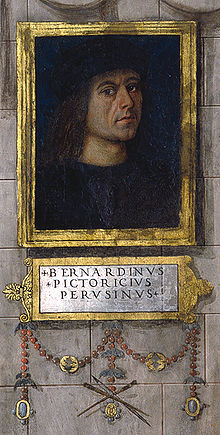Bernardino Pinturicchio
| Bernardino Pinturicchio | |
|---|---|

Self-portrait in the Baglioni Chapel.
|
|
| Born |
Bernardino di Betto 1454 Perugia, Umbria, Italy |
| Died | 1513 Siena, Toscana, Italy |
| Nationality | Italian |
| Education | Pietro Perugino |
| Known for | Painting, Fresco |
| Movement | Italian Renaissance |
Pintoricchio or Pinturicchio (Italian: [pintuˈrikkjo]) whose formal name was Bernardino di Betto, also known as Benetto di Biagio or Sordicchio, was an Italian painter of the Renaissance. Born in Perugia in 1454 and dying in Siena in 1513, Pintoricchio acquired his nickname, meaning ("little painter"), because of his small stature. He also used it to sign some of his 14th and 15th century artworks.
Pinturicchio was born the son of Benedetto or Betto di Blagio, in Perugia. In his career, he may have trained under lesser known Perugian painters such as Bonfigli and Fiorenzo di Lorenzo. According to Vasari, Pinturicchio was a paid assistant of Perugino.
The works of the Perugian Renaissance school are very similar; and paintings by Perugino, Pinturicchio, Lo Spagna and a young Raphael may often be mistaken one for the other. In the execution of large frescoes, pupils and assistants had a large share in the work, either in enlarging the master's sketch to the full-sized cartoon, in transferring the cartoon to the wall, or in painting backgrounds or accessories. His assignment in Rome, to decorate the Sistine Chapel, was an experience fraught with learning from prominent artists of the time, including: Sandro Botticelli, Domenico Ghirlandaio, Pietro Vanucci, and Luca Signorelli. The Sistine Chapel was also where it is believed that Pinturicchio was collaborating with Perugino to some extent.
After assisting Perugino in his frescoes in the Sistine Chapel, Pinturicchio was employed by various members of the Della Rovere family to decorate the Semi-Gods Ceiling of Palazzo dei Penitenzieri and also a series of chapels in the church of Santa Maria del Popolo, where he appears to have worked from 1484, or earlier, to 1492. "Would be, if it had been left with all its original decorations, one of the finest monuments to Pintoricchio’s art in Italy. A great deal still remains, but much has been swept away", sums up his work in that basilica Evelyn March Phillipps.
...
Wikipedia
